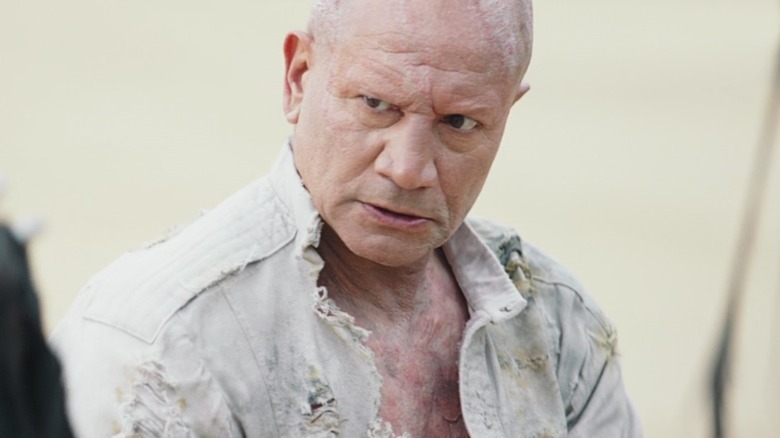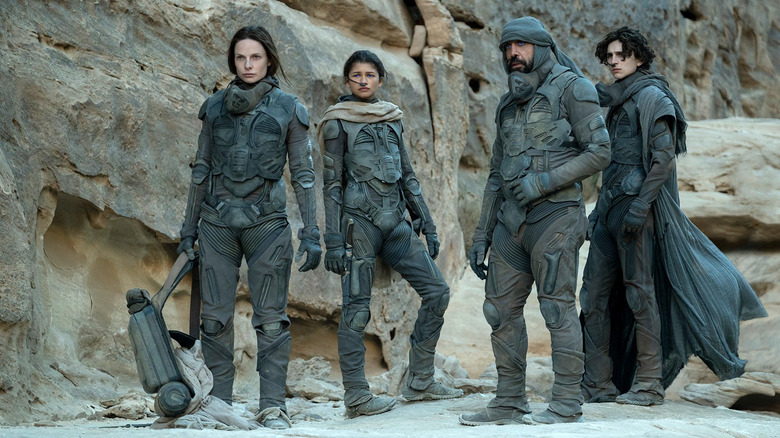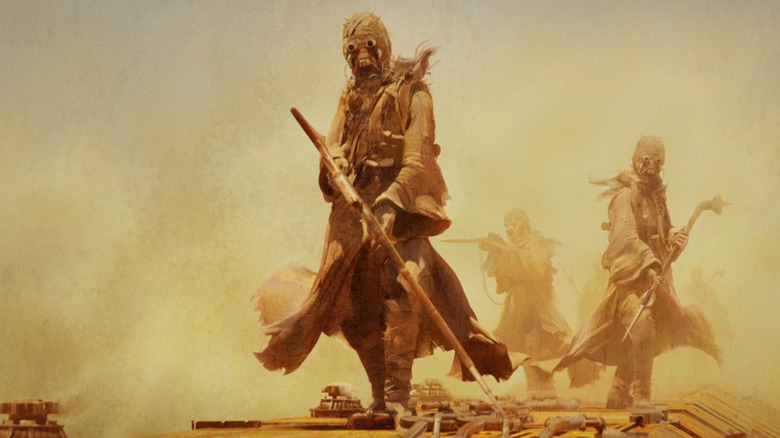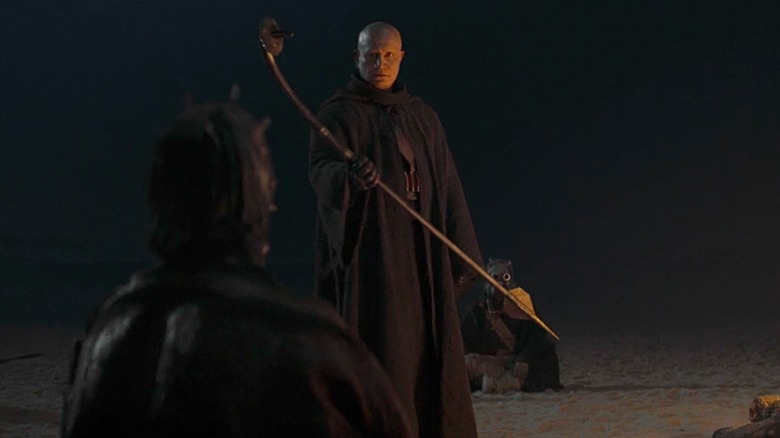The Book Of Boba Fett Episode 2 Pays Tribute To Dune, One Of Star Wars' Biggest Influences
After a slightly rocky start to the series, "The Book of Boba Fett" episode 2, "The Tribes of Tatooine," picks up a gaffi stick and beats the audience over the head with "Dune" references — and what a beautiful beating it is.
It's no secret that Frank Herbert's beloved science fiction novel "Dune" was a major influence for George Lucas when he first began building the world of "Star Wars." The traces of "Dune" are particularly evident on the planet of Tatooine, with its Dune Sea and the Tusken Raiders that live out in those harsh desert conditions. The Tuskens' appearance and culture were loosely based on Bedouin tribes, and they also serve as the Native American analog within Lucas' space Western.
Like the Fremen in "Dune," the Tusken Raiders are not tied to any single real-world culture, but draw influences from cultures ranging from the Bushmen of the Kalahari Desert to Pacific Islanders (the gaffi stick itself is based on a Fijian weapon called a totokia). Though Tusken culture was expanded upon in some of the Star Wars Legends stories, they've been something of an enigma in the "Star Wars" movies and TV shows. There's not even a clear answer to what their faces look like under all those coverings.
Both "The Mandalorian" and now "The Book of Boba Fett" spotted this opportunity to make Tusken Raiders their own. "The Mandalorian" season 2 premiere, "The Marshall," saw Din Djarin and Cobb Vanth form a temporary alliance with the Tuskens in order to take down a krayt dragon (another "Dune" homage; the krayt dragon bears a strong similarity to the sandworms of Arrakis). When Temuera Morrison made his dramatic return as Boba Fett later on in "The Mandalorian" season 2, it was revealed that he'd survived in the deserts of Tatooine thanks to a little help from the Tusken Raiders, and he had even adopted their signature weapon and fighting style.
Dune, in a Nutshell
If you haven't read Frank Herbert's "Dune" or seen any of the adaptations (including Denis Villeneuve's excellent new film, which released last year and has a sequel already in motion), here's a quick guide. In the world of "Dune," the Known Universe is ruled over by an emperor with various noble families serving him. Among two of the most powerful families are House Harkonnen and House Atreides. Fearing their growing strength, the emperor plots to kill two birds with one stone by pitting the Atreides and Harkonnen families against one another.
For many years the Harkonnens have been granted the fiefdom of Arrakis, a desert planet that happens to be the only place where you can find spice, the most valuable substance in the universe. Spice has psychoactive effects that turn people's eyes a distinctive blue color if they breathe in enough of it over a long period of time, but more importantly it's essential for interstellar travel — without spice, the Imperium would cease to be an empire and simply become a collection of isolated solar systems. To ensure the steady flow of spice, Arrakis has been colonized by the Imperium, and the Harkonnens oversee the mining of spice on the planet, growing obscenely wealthy from it.
At the beginning of "Dune," the emperor effectively yanks this toy out of the Harkonnens' hands and gives it to House Atreides with the intention of starting a fight. For Duke Leto Atreides, Arrakis is a white elephant: presented to his family in the guise of a lavish gift, but intended to be his downfall. Knowing this, the duke seeks to ally himself with the Fremen, the indigenous people of Arrakis. The Fremen have resisted colonization by hiding out in the deep deserts, which are a dangerous place for outsiders due to the ever-present threat of sandworms and the lack of readily available water. The Fremen, however, are well adapted to desert life and have designed outfits called "stillsuits" to help them to survive out in the dunes.
Before Duke Atreides can firm up this new alliance, House Atreides is betrayed and the Harkonnens attack Arrakis with the intention of taking "their" planet back. The duke's son, Paul, escapes into the desert and proves himself to the Fremen in combat, learning from them and teaching them some skills of his own, and eventually leading them in battle to overthrow their oppressors. Sound familiar?
A Loving Homage
"The Book of Boba Fett" could have shied away from the franchise's "Dune" influences and tried to conceal them, but it's an open secret that writers steal ideas ("Dune" itself was heavily influenced by "Lawrence of Arabia" and Isaac Asimov's "Foundation"), and that is by no means an inherently bad thing. To quote Mark Twain:
"There is no such thing as a new idea. It is impossible. We simply take a lot of old ideas and put them into a sort of mental kaleidoscope. We give them a turn and they make new and curious combinations. We keep on turning and making new combinations indefinitely; but they are the same old pieces of colored glass that have been in use through all the ages."
Perhaps taking advantage of Villeneuve's "Dune" adaptation bringing the story to a new generation of science-fiction fans last year, "The Book of Boba Fett" shines a light on all the grains of "Dune" scattered across the "Star Wars" galaxy. The train that Boba and the Tuskens take down is carrying sansanna spice, a substance mined by slaves on Kessel, which is based on and strongly resembles the much-coveted spice of "Dune" (which in turn drew from the British colonization of India and the spice trade — again, "no such thing as a new idea"). In the same scene where the spice is revealed, Boba tells the members of the syndicate who were smuggling it that the "Dune Sea" belongs to the Tuskens, driving home the association with "Dune" and the Fremen.
Boba's time with the Tusken Raiders also mirrors Paul Atreides' integration into the Fremen and the well-worn trope of two different cultures combining the best of their knowledge to become an even more formidable fighting force. Of course, this trope is not unique to "Dune," but is found across the wide landscape of storytelling ("The Last Samurai" and "Avatar" both deployed it, and in "Return of the Jedi" the Ewoks' guerrilla fighting tactics are essential to the Rebels' defeat of the Imperial forces on Endor). It's a story structure that has historically had a lot of crossover with the problematic "white savior" trope, but "The Book of Boba Fett" seems to be conscious of this pitfall and makes efforts to sidestep it.
This is the Way
For starters, the "white savior" figure in "The Book of Boba Fett" isn't white; Temuera Morrison is a Māori and in an interview with StarWars.com spoke about coming from a "warrior background" in his home country of New Zealand, and how it influenced his portrayal of Boba. In this case, the culture that the character is integrated into actually draws influences from the actor's own heritage, and Boba's "rebirth" among the Tuskens is quite a clever way of incorporating Morrison's cultural identity into the series without retconning Boba's previous appearances in "Star Wars." Speaking to the New York Times about the return of his character in "The Mandalorian," Morrison explained:
"I come from the Māori nation of New Zealand, the Indigenous people — we're the Down Under Polynesians — and I wanted to bring that kind of spirit and energy, which we call wairua. I've been trained in my cultural dance, which we call the haka. I've also been trained in some of our weapons, so that's how I was able to manipulate some of the weapons in my fight scenes and work with the gaffi stick, which my character has."
This deeper dive into the real-life cultures that influenced the world-building of "Star Wars" could be the way forward for the franchise after the mixed response to the sequel trilogy. "Star Wars: The Last Jedi" openly rejected the franchise's obeisance to the Sacred Skywalkers and argued (albeit from the lips of an antagonist) in favor of letting the past die; killing it if you have to. A certain portion of the "Star Wars" fandom did not like that at all, so "The Force Awakens" director J.J. Abrams was called back in to yank the steering wheel hard in the opposite direction: "Just kidding! Skywalkers are still the most important people in the galaxy, and Rey isn't just a random person, she's actually Emperor Palpatine's granddaughter, and Palpatine is back too, and — hey, where are you going?"
Yes, it turns out that the "Star Wars" fandom (and general moviegoing audiences) liked that even less than "The Last Jedi." But there is another way — a place of balance in the Force, if you will. The recent anime anthology series "Star Wars: Visions" paid tribute to the franchise's genre origins (Westerns and samurai films share a lot of DNA, and Lucas has been outspoken about his love for the works of Akira Kurosawa) by commissioning nine short films from seven different Japanese animation studios, with some truly wonderful results. Rather than striving to make "Star Wars" feel as alien as possible and cutting ties to any real-world influences, "Star Wars: Visions" greatly benefited from embracing the franchise's links to Japanese storytelling. Similarly, one of the best episodes of "The Mandalorian" season 2 was an overt homage to Kurosawa's film "The Hidden Fortress," whose influence can also be seen all over "Star Wars."
One of the biggest challenges that "The Book of Boba Fett" will face is losing the baggage of being seen as a "Mandalorian" spin-off and finding its own identity. And just as "Star Wars: Visions" found its own identity in anime, "Boba Fett" can go all-in on Māori and New Zealander influences (after the first episode released, I saw quite a few Kiwis who were delighted that "mate" had formally made its way into "Star Wars" vernacular).
"Diversity" isn't just a buzzword; it's something that's desperately needed to keep a 40-year-old franchise feeling fresh and interesting. And "The Book of Boba Fett" episode 2 proves that you can also make "Star Wars" feel fresh and interesting by shamelessly and lovingly rehashing the plot of one of the most well-known sci-fi novels ever written.
"The Book of Boba Fett" episode 3 releases Wednesday, January 12, on Disney+.



